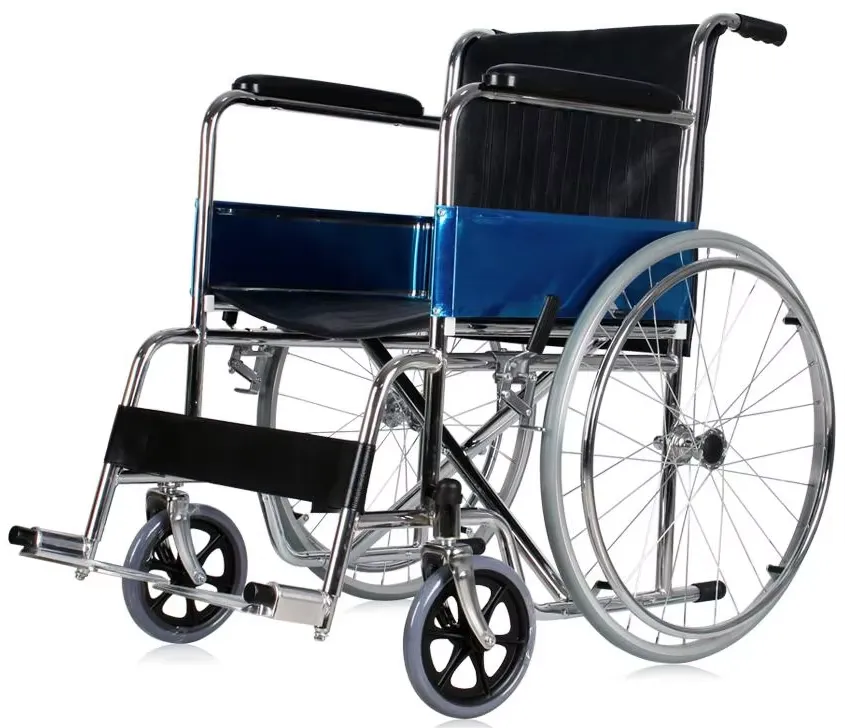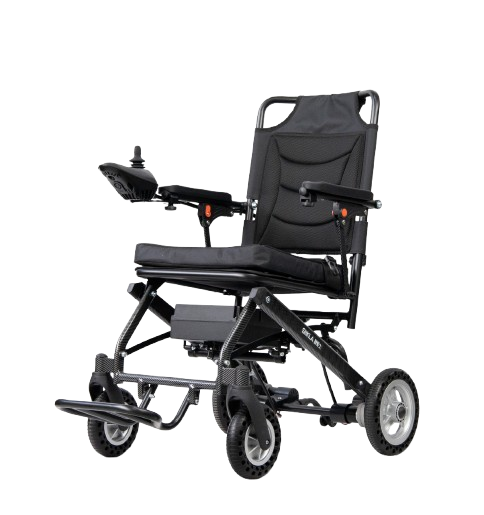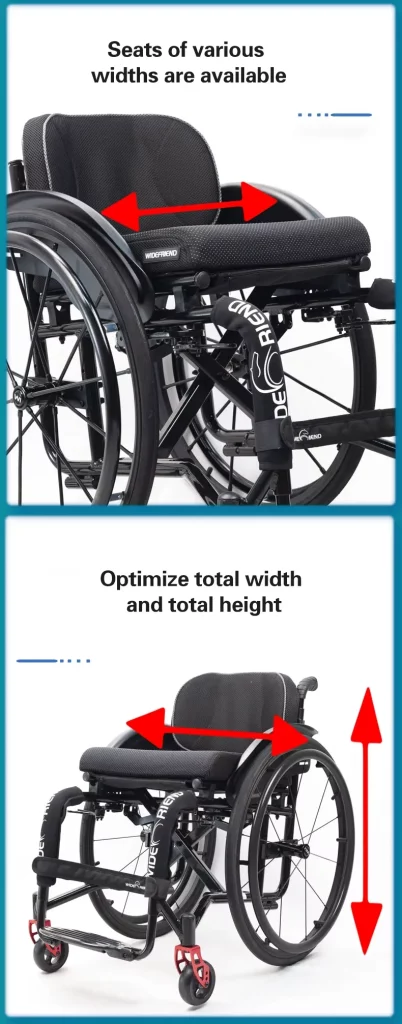Forget everything you think you know about what a wheelchair is. For decades, a crippling paradox has defined mobility design: strength meant burdensome weight, while lightness meant unnerving fragility. You were forced to choose. We refused to accept that compromise.
This isn’t just about bending metal. It’s a masterclass in material science, a deep dive into kinematic alchemy, and a study in load-bearing architecture borrowed from aerospace and motorsport. We challenged our engineers to solve the unsolvable: to forge a frame that folds with a whisper but provides unyielding structural integrity. The result is more than a chair; it’s a meticulously engineered extension of your will, designed for effortless freedom.
We’re pulling back the curtain to reveal the hidden genius—from our patented “no-pinch” folding system to the geometric secrets that transform advanced alloys into your ticket to an easier life. Ready to see how?
It’s More Than Just a Chair: Why Smart Engineering Means More Freedom for You
Let’s be honest. When you think about a foldable wheelchair, the word “engineering” might make your eyes glaze over. You’re probably thinking more about practical questions: “Is it easy to lift into my car?” “Will it be comfortable to sit in all day?” “Can I navigate tight corners at the grocery store without a 12-point turn?”
Those are the questions that truly matter. And the brilliant thing is, the answer to every single one of them lies in engineering.
Smart engineering isn’t about complicated jargon or blueprints only a specialist can read. It’s about a deep, relentless focus on the user. It’s the invisible force that makes your day easier, reduces the physical strain on you and your loved ones, and ultimately unlocks a new level of enhanced independence. A well-engineered wheelchair isn’t just a mobility aid; it’s a passport to a more active, spontaneous, and hassle-free daily life. It’s the difference between feeling limited by your equipment and feeling empowered by it.
The Big Challenge: How Do You Make a Wheelchair Strong, Durable, and Feather-Light?
For years, the wheelchair industry was stuck. The fundamental challenge seemed impossible to solve. To build a strong, durable construction that could withstand years of daily use, manufacturers relied on heavy, bulky materials like steel. These chairs were sturdy, no doubt, but they were also incredibly heavy. This created a huge physical burden on users, who found self-propulsion exhausting, and on caregivers, who dreaded the thought of lifting the chair into a car trunk.

On the other hand, attempts to create lightweight wheelchairs often resulted in flimsy, fragile frames. They were easier to lift, but they lacked the rigidity and structural integrity needed for a smooth, stable ride. Users often felt insecure, and the chairs couldn’t handle the rigors of varied terrains or an active lifestyle.
This was the compromise we refused to accept. We asked our engineering team a simple but profound question: How can we achieve maximum strength with minimum weight? The answer wasn’t a single “eureka” moment, but a combination of three key pillars: advanced materials, a revolutionary folding mechanism, and smarter frame geometry.
It All Starts with the Skeleton: The Magic of Advanced Materials
The single biggest factor in a wheelchair’s weight and performance is the material used to build its frame. This is where our journey to create the ultimate lightweight foldable wheelchair began.

Goodbye, Heavy Steel: Why Traditional Materials Just Don’t Cut It Anymore
For a long time, steel was the standard. It’s strong and inexpensive. However, it’s also incredibly heavy and prone to rust if its coating is compromised. A heavy frame means:
- More Propulsion Effort: Every push requires more energy from you, leading to less fatigue being a distant dream. This can strain your shoulders and wrists over time, increasing the risk of repetitive strain injury (RSI).
- Reduced Portability: Lifting a heavy steel chair is a significant challenge, limiting travel and spontaneous outings. It’s a classic barrier to independent living.
- Caregiver Strain: The weight poses a real risk of back injury to family and friends who assist with transport.
We knew that to revolutionize mobility, we had to leave heavy steel behind and explore the world of advanced materials science.
Our Go-To Choice: The Strength and Lightness of Aerospace-Grade Aluminum
Our primary material of choice is aerospace-grade aluminum, specifically high-strength aluminum alloys. This isn’t the same aluminum you find in a soda can; this is a sophisticated material engineered for applications where strength and lightness are critical, like in aircraft and high-performance vehicles.
Here’s why it’s a game-changer:
- Incredible Strength-to-Weight Ratio: This is the magic formula. Aerospace-grade aluminum offers the strength needed to create a robust, durable and dependable frame but at a fraction of the weight of steel. This weight reduction engineering is key to our design.
- Natural Corrosion Resistance: Unlike steel, aluminum forms a protective oxide layer that makes it naturally rust resistance, ensuring device longevity even in damp climates.
- Precision Engineering: Aluminum alloys are fantastic to work with. We use advanced manufacturing techniques like hydroforming, where fluid pressure is used to shape the metal tubes into complex, optimized forms. This allows us to create a stronger, more rigid frame with no welds in critical stress areas, which are often points of failure. This precision engineering results in a sleek, minimalist design.
By using this high-grade aluminum, we build chairs that are not only incredibly light but also possess the sturdiness and long-term reliability you need to live with confidence.
Pushing the Limits: When and Why We Use Ultra-Light Carbon Fiber
For users who demand the absolute pinnacle of performance and the lowest possible weight, we turn to carbon fiber. Once the exclusive domain of Formula 1 cars and Tour de France bikes, we’ve made this ultra-lightweight material a cornerstone of our premium models.
Carbon fiber reinforced composites are extraordinary. They consist of powerful carbon fibers woven together and set in a polymer resin. The result is a material that is:
- Impossibly Light: A carbon fiber wheelchair frame can be significantly lighter than even an aluminum one, making it the ultimate choice for easy portability and travel. The reduced physical effort needed for propulsion is immediately noticeable.
- Extremely Rigid: Don’t let the lightness fool you. Carbon fiber has a phenomenal strength-to-weight ratio. This rigidity translates directly into performance—every bit of energy you put into the pushrims moves the chair forward, with nothing lost to frame flex. This is what we call propulsion efficiency.
- Superior Vibration Damping: One of the unsung heroes of carbon fiber is its natural ability to absorb bumps and vibrations from the ground. This creates a much smoother ride and reduces the fatigue that can build up over a long day.
Building with composite materials like carbon fiber is a highly specialized manufacturing process, but for those seeking the ultimate in lightweight design and performance, the benefits are undeniable.
The Art of the Fold: A Look Inside Our Patented Folding Mechanism
A lightweight frame is only half the battle. If a foldable wheelchair is clunky, complicated, or unsafe to fold, it fails the test of daily life. We poured countless hours of R&D into reinventing the fold itself, focusing on simplicity, safety, and a compact design.
From Clunky to Compact: How We Designed a Seamless One-Hand Fold
We’ve all seen it: the awkward struggle to collapse a poorly designed chair, trying to align stubborn parts while balancing it against your leg. Our goal was to eliminate that frustration entirely.
Our engineers developed a quick-folding mechanism that is both intuitive and mechanically elegant. We obsessed over the kinematics—the science of motion—of every hinge and lever. By using a symmetrical X-cross brace design and high-precision pivot axles, we created a folding mechanism that collapses smoothly and predictably.
The result is what we call the FreeFold design. It allows many of our chairs to be folded with a single hand in one fluid motion. This makes a world of difference when you’re holding a bag, opening a car door, or simply need to store the chair quickly. It’s a design that provides true convenience and ease of use, transforming a daily chore into an effortless action. The chair collapses into a compact size, perfect for convenient storage in car trunks, closets, or even the overhead compartments on an airplane.
Safety is Key: Our “No-Pinch” Hinge System Explained
Speed and convenience can never come at the expense of safety. A major focus of our design process was creating a folding hinge that protects the user. Traditional cross-brace designs often create dangerous pinch points where fingers can get caught during folding or unfolding.
Our solution is a system of carefully designed guards and a zero-gap tolerance in the hinge mechanism’s final state. This ensures that as the frame folds, there are no exposed gaps where fingers can be accidentally trapped. It’s a simple but critical safety feature that provides peace of mind every time you handle the chair. This commitment to user safety standards is non-negotiable in everything we build.

Building a Better Backbone: The Hidden Genius in Our Frame Geometry
Have you ever wondered why a bridge can support thousands of tons of traffic while looking so delicate? The secret isn’t just the material; it’s the shape. The same principle applies to our wheelchairs. The frame geometry—the specific angles, tubes, and connections—is the hidden genius behind the chair’s unshakeable strength and smooth performance.
Inspired by Bridges and Race Cars: Using Smart Shapes for Unshakeable Strength
Our engineers use powerful Computer-Aided Design (CAD) software and Finite Element Analysis (FEA) to digitally simulate how forces are distributed across the frame. This allows us to see exactly where stress is concentrated during activities like rolling over a curb, making a sharp turn, or braking suddenly.
This analysis informs our design in several ways:
- Strategic Reinforcement: Instead of making the entire frame thicker (and heavier), we can strategically reinforce only the areas that bear the most load.
- Optimized Tube Shapes: You’ll notice that some of our frames use ovalized tubing instead of simple round tubes. This isn’t just for aesthetics. An oval shape can provide significantly more rigidity in one direction, preventing the frame from flexing and wobbling without adding extra weight.
- The Power of the X-Frame: The X-frame or cross-brace mechanism is a classic for a reason. It’s an incredibly efficient way to distribute forces, providing lateral stability and creating the foundation for a reliable folding system. We’ve refined this design to maximize rigidity while minimizing weight.
By borrowing principles from civil engineering and motorsports, we build a frame that is both incredibly strong and dynamically responsive.
Why a BetterFrame Means a Smoother, More Comfortable Ride
A rigid, well-engineered frame does more than just ensure durability. It directly translates to a better experience for you, the rider.
- Improved Maneuverability: A rigid frame doesn’t waste your energy by flexing. When you push, the chair goes exactly where you want it to go, with instant responsiveness. This makes navigating tight spaces, like crowded aisles or narrow doorways, significantly easier.
- Enhanced Stability: A well-designed geometry, combined with an optimal center of gravity (CG), creates a feeling of balanced stability. You feel connected to the chair and confident in its movements, reducing the risk of wobbling at higher speeds.
- Superior Comfort: A stiff frame helps the suspension and wheels do their job of absorbing bumps, leading to a smoother ride. It also provides a solid base for our ergonomic seating systems, ensuring you get the postural support you need to stay comfortable all day long.
It’s the Little Things: Reinventing Every Single Component for You
A truly great wheelchair is more than just a great frame. It’s a complete system where every single component is designed to work in harmony. We’ve applied the same philosophy of lightweighting, performance, and user-centric design to every part of the chair.
Not Just Any Wheels: How We Engineered Effortless Gliding
The wheels are your connection to the world, and they play a huge role in propulsion efficiency. We focused on minimizing rolling resistance—the force that works against you with every push.
We achieve this through:
- High-Performance Tires: We use explosion-proof solid tires made from advanced polyurethane (PU) materials that offer the perfect balance of grip and low resistance.
- Precision Bearings: The hubs of our wheels contain high-quality, sealed bearings that allow the wheels to spin freely with almost no friction.
- Shock Absorption: Some of our models feature shock-absorbing wheels or frame designs that help dampen vibrations, further enhancing comfort and reducing fatigue on uneven surfaces.
Many of our chairs also come with quick-release wheels. With the push of a button, you can pop the rear wheels off, making the chair even more compact and lighter for transport and storage.
Brakes You Can Count On: Combining Stopping Power with Easy Handling
A wheelchair’s braking systems are a critical safety component. They need to provide absolute, reliable stopping power, but they also need to be easy to engage and disengage, even for users with limited hand strength.
Our ergonomic brake levers are designed for easy gripping and require minimal physical effort to lock into place. We also offer options like dual brake systems, which provide additional control for caregivers. We conduct rigorous brake effectiveness tests under various conditions to ensure our brakes meet and exceed stringent safety standards, giving you the confidence that you can stop securely whenever you need to.
From a Computer Screen to Your Daily Life: Our Relentless Testing Process
A design that looks good in a CAD program is meaningless until it’s proven in the real world. Our commitment to quality and safety is backed by one of the most rigorous testing protocols in the industry. Every one of our designs endures a gauntlet of tests before it ever reaches you.
The “Worst-Case Scenario” Tests: Simulating Years of Real-World Use in Days
We don’t just test for average use; we test for the unexpected. Our in-house and third-party testing laboratories put our wheelchairs through hell and back to ensure they are safe and durable.
- Durability and Fatigue Testing: Robotic test rigs simulate a user sitting down, standing up, and rolling over bumpy surfaces thousands upon thousands of times. This simulates years of wear and tear in a compressed timeframe, allowing us to identify and strengthen any potential weak points.
- Load Testing: We test the chair’s load bearing capacity far beyond its stated weight limit to ensure a massive safety factor.
- Impact and Crash Testing: Following international standards like ISO 7176, we perform impact tests and simulate transport-related events to ensure the chair’s structural integrity and your safety.
This rigorous quality testing ensures that your wheelchair is not just a purchase for today, but a reliable partner for years to come.
Listening to You: How Your Feedback Shapes Our Next Generation of Chairs
The most important experts in wheelchair design aren’t our engineers—they’re you. User feedback is the lifeblood of our innovation. We actively engage with the community of “wheelchair junkies” and daily users through user trials, surveys, and direct conversations.
We want to know what works, what doesn’t, and what your dream features are. Do you need a different kind of armrest? A more breathable cushion? An even smaller turning radius? This feedback goes directly back to our design team and plays a crucial role in the product development of our next-generation models. This user-centric design approach ensures that we aren’t just building what we think is best; we’re building what you know you need.
Putting It All Together: Smarter Engineering for an Easier Life
As you can see, creating a world-class lightweight foldable wheelchair is a journey of a thousand tiny decisions. It’s the choice of aerospace-grade aluminum over steel. It’s the precise angle of a frame tube. It’s the satisfying, secure click of a “no-pinch” hinge.
Each of these engineered details comes together to create a seamless experience. The end result is a chair that doesn’t hold you back. It’s a chair that’s easy to propel, giving you the enhanced endurance to go further with less fatigue. It’s a chair that’s simple to fold and lift, giving you the freedom to say “yes” to spontaneous trips. It’s a chair that gives you an improved quality of life by enhancing your mobility, boosting your confidence, and supporting your desire for an active, independent life.
That’s the true purpose of all our engineering: to make your life easier, one brilliant detail at a time.
Ready to Feel the Difference for Yourself? Explore Our Models
Reading about innovative engineering is one thing, but experiencing it is another. We invite you to explore our range of lightweight foldable wheelchairs and discover the model that’s the perfect fit for your lifestyle. Feel the effortless glide, the secure fold, and the unshakeable stability for yourself. Your journey to greater freedom starts here.

